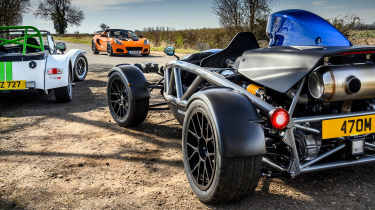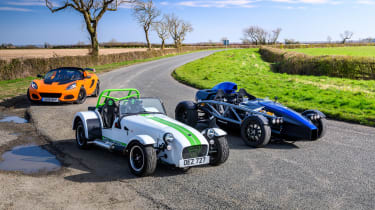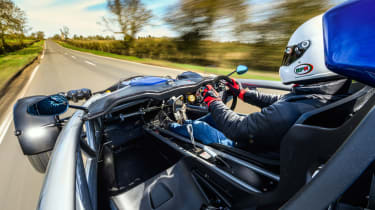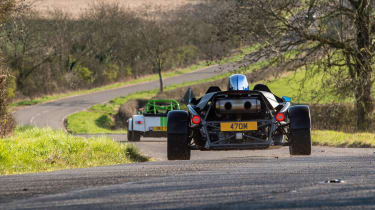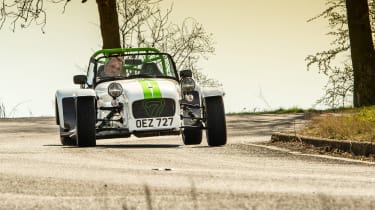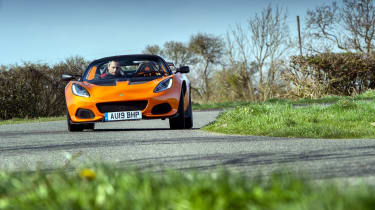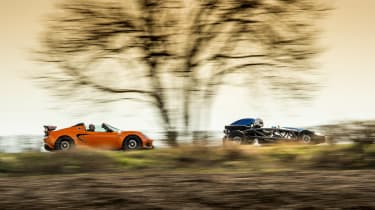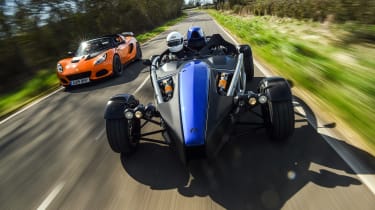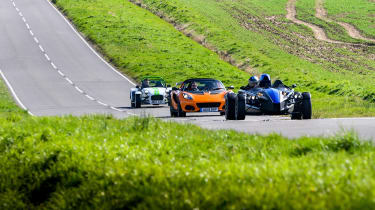Ariel Atom 4 v Caterham Seven 310R v Lotus Elise Cup 250
Nowhere makes small, lightweight sports cars like Britain. But which is the best of the current sub-£50k crop: Ariel Atom 4, Caterham Seven 310R or Lotus Elise Cup 250?
As I write, Britain is suddenly in the midst of spring. Rich, vibrant colours not seen for the past six months are screaming from every hedgerow. Trees are no longer sticks of brown, but textural and lush, and the very air has a different temperature – an encouragingly warm touch against the skin. Pigeons coo high up in the foliage, and that round yellow ball, so missed in grey, wet February, makes its presence known as well, and no longer just visually. There’s heat to those rays, at last.
But the best bit? The B-roads – no longer mud-strewn and slippery, or constantly cracking apart under the onslaught of frost. Now they snake invitingly across the land, creating an arena that I imagine motivated most of us from the very beginning, me included. This will always be the root of my driving dreams; simple, earnest driving, a human activity where horsepower numbers, top speed, and pounds, shillings and pence just don’t matter.
> 2023 Lotus Eletre debuts – Lotus plugs itself into electric future
They are also empty. Invitingly so, in a manner without precedent. Alas, although I never thought I’d type this, that isn’t a good thing, for it betrays the fact that the UK, like much of the rest of the world, is now on lockdown, as the horrendous Covid-19 pandemic sweeps the planet.
Now our beloved driver’s cars are silent. Highly tuned engines sit idle, cold and dormant, a fresh web between alloy wheel spokes, a layer of surface rust on a brake disc. For now, they no longer matter, and yet the very thought of them also provides a small distraction from the horror we read and witness, and the alien, isolated lifestyle we have been forced to adopt. It’s that mental escape that provides a tiny element of salvation. The fantasy of an open road, testing and challenging. A small, lightweight car, with no numbing barrier of flab and electronics between man and machine. Driving as it should be. Driving for fun.
And driving for fun is exactly what we had in mind when, just hours before the lockdown was announced, we brought together three prime examples of the sports car breed: Ariel’s Atom 4, Caterham’s Seven 310R and Lotus’s Elise Cup 250. Patriotism aside, no one makes this sort of car better than the British.
A further catalyst for our gathering was the advent of the Atom 4, because while we featured it in an evo Driven back in issue 255, a comparison with rivals was long overdue. Even though that first drive was a brief one, it was more than enough to convince me that the Atom 4 was special, a worthy successor to the previous products of this quintessentially British but fearsomely independent-of-thought sports car stalwart, now 20 years young and counting. Ariel, small but focused, remains a wonderful example of delivering a unique and well-executed product to the right audience, and building that market diligently over successive years.
I pull my crash helmet down past my ears and nestle into the 4’s uncompromising but supportive bucket seat. As ever, the sheer sparseness of the Atom is a shock – there’s fresh air where there would normally be at least some membrane of bodywork on even the most basic of small sports cars. There is nowhere to keep anything – not a cubby hole, nor netting. The phone gets stuffed into a pocket, ditto the wallet, and anything else is liable to be sucked out in a vortex into the surrounding countryside.
While it may look like an earlier Atom, the 4 is, in fact, a fundamentally different car. Longer in wheelbase and turbocharged of engine, it shares just three parts with its forebears – clutch pedal, brake pedal and fuel cap. I had forgotten how shocking the 4’s stats are; the fact that, running an MBE ECU, the Civic Type R engine makes 320bhp and 310lb ft of torque in a car that sits on the scales at only 595kg. Even on the lightest of throttle openings, the four-pot motor still warming up and the three-position map switch set to 1 for around 200bhp, the way the 4 accrues speed is absolutely demonic. So I lift my right foot, and the world’s loudest dump valve releases excess pressure seemingly about 10mm from the back of my head. Calm, and breathe…
That’s not the only major first impression the 4 makes. The other is one of quality. The exoskeleton chassis structure is made from thicker metal now for increased rigidity, the new dash set-up is clear, colourful and attractive, and everywhere you look and touch the Atom impresses with its attention to detail and standard of build. It’s like a motorbike in the sense that its constituent parts are attractive in themselves, rightly placed on show. You might, pretentiousness aside, call it art.
The first time you give the Atom everything on map 3 you want to scream. It’s a futile scream, filtered by the dampening effects of a crash helmet’s lining and then whipped away in the vicious slipstream before it can make itself heard, but it’s an involuntary reaction to the immense feeling of weightlessness and full afterburner propulsion that the Ariel offers (0-60mph takes a stark 2.8sec). It’s a car that feels inherently lighter than the other two here, even if the venerable Seven is on a par on the scales, because everything about it has a lightness of touch, and when combined with the immense thrust from over your shoulder, the cumulative effect is a bit like hovering above the road’s surface – of being, literally, airborne. The steering requires fingertip levels of interaction, the gearlever slices through the gate as though the mechanism is taken from a wristwatch, and there’s little muscle power required in operating the pedals. The optional Öhlins dampers on this example give it an amazingly supple yet brilliantly controlled ride quality.
This can all make the first few miles at speed in the Atom a quite overwhelming experience. With its engine set so far rearwards – almost over the rear axle line – and so little weight on the front end, the Ariel requires an understanding of its physics to reassure the more reactionary part of the brain that all will be well – that you will get on top of this barely caged animal.
It really says something when you divert to a Caterham for a saner experience. I love the white with green stripes of this particular 310R, with its diddy 13-inch wheels, chunky Avon semi-slick tyres and matching green roll bar. Of course, it’s not a direct rival for the Atom, this being a Seven with only 152bhp and a kit-built start price of £28,990 (Caterham will build it for you for an extra £2395). This car has the £1000 R pack, a proper windscreen and the stickier tyres, so that figure soon passes 30 grand, but still, it’s a long way short of the near-£40k Atom by most measures.
As ever, the standard Series 3 Caterham chassis is about half a size too small for my six-foot-plus frame, even with the lightweight R seats. I often think this is precisely the moment where the modern world misses the point with a vehicle such as the Caterham Seven. The logical, customer clinic-led course of action would be to make it bigger, more comfortable, more useable. Why not? The reason not to, of course, is that to do so would be to lose the inherent qualities that make the Seven what it is. It may be a cliché, but you wear this car, the simple box chassis almost against the skin in places. It makes it light, and it makes it small – so small, that even on a B-road there is ample room in your lane. So what if you can’t wear normal shoes, or you have to hunch a bit to get fully behind the rudimentary windshield, or that elbow room is laughably tight? Generations of Seven drivers have understood that these are necessary compromises, the suffering for their art, to access all the wonderful things about driving this car.
After the Atom, the 310R seems hardwired to the driver. That’s not a criticism of the Ariel, just that being in the Caterham feels unbelievably cramped after the larger, open-air Atom, while the stingingly sharp throttle response of the tweaked, naturally aspirated Ford Sigma 1.6-litre engine is far beyond what even a modern turbocharged engine can offer. Conversely, everything about the way it works has a heavier, much more mechanical feel. On its standalone management and hotter cams, the 310 is a vastly more desirable package than the rather asthmatic 270 model, and the spits and entirely natural bangs from the side-exit exhaust just centimetres from your right ear can’t help but make you grin, as does the engine’s lunge for the shift light above 5000rpm.
The beauty of the 310 package is that it’s fast enough to be vividly exciting, while at the same time not so fast as to be alarming or, perhaps even more importantly, so fast that rinsing the Sigma motor senseless would put you too far into the realms of social and legal unacceptability. There really isn’t anything quite as satisfying as driving a car hard, hence why so many memorable drives take place in basic hire cars, and the 310R sits very nicely on the cusp between frenzied aggression and rorty innocence. Zero to 60mph in a fraction under five seconds is more than quick enough.
Before I get too comfortable spending the day blasting through the gently rolling hills of Bedfordshire, I think I should grab the key to the Elise. It’s in danger of being a little overshadowed here by the manic purposefulness of the other two because the Lotus is a proper car, as in it has actual windows, a decently habitable interior, luggage space, and a proper roof. It is a car you could use as a daily driver, with perhaps only a little more commitment than usual. But don’t make the mistake of thinking this makes it the dull car here. In £49,555 Cup 250 form, weighing 931kg, it easily outsprints our Caterham to 60, recording the dash in just 3.9sec before going on to a top speed of 154mph.
Its supercharged 1.8-litre Toyota engine makes 245bhp, and Lotus has worked hard on the noise it makes, so where once a hardcore Elise’s voice was dominated by a whining supercharger, these days it’s a fruity exhaust note to the fore that sounds more like an Alfa twin-cam on carbs. The character of the ZR unit is quite different to that of the previous ZZ engine of the same capacity, too. Where the ZZ would do nothing until around 6000rpm, and then go mental on the second set of cam lobes until nearly 9000rpm, the ZR is much more linear, delivering a solid lunge of power and torque from much lower down the rev range. The flip side is there’s no longer the mad thirst for revs, the engine easily tripped up by the rev limiter at 7000rpm.
If subjectively the Elise feels the slowest, even if it isn’t, then it has nothing to be ashamed of in the corners. Over the past few years Lotus has struggled financially, as it so often has in its history, and while its management sought to put the company on a secure footing before the sale of the business to Geely, one element that was pruned back was the press fleet. That’s why you won’t have seen many Elises in the pages of evo over recent years, and driving this Cup 250 is a reminder of what we’ve been missing out on.
It may be advanced in age, but it is as effective, enjoyable and essential as ever. For a magazine that has gone wild for the Alpine A110, having a good thrash in an Elise highlights a number of weaknesses in the French car. Where the gearchange was once a Lotus weak spot, now the beautiful exposed mechanism is an instrument that you’ll use to change gears just for the sake of it. Likewise the steering, unassisted and with entirely natural feedback so clear it’s as though the car is actually shouting at you, really highlights where the A110 could do with significantly more tactility. Pretty damn quickly I am utterly engrossed.
After a breather and a natter about the cars, I switch back into the Atom, and sense that I’m beginning to get my head around its performance. In the lower gears the acceleration is so fierce that there’s barely time to remove your palm from the silver sliver of a gearlever, and while it’s beautifully light and accurate, I reckon a physical open gate would provide a little more assurance when you’re whipping the lever through as fast as possible that you won’t inadvertently miss a shift.
So sensitive is the Atom that it requires a really calming influence. That initial turn into a corner can give a brief impression of understeer – something about the way the weighting doesn’t build and the car not turning quite as much as you’d expect. So use the brakes to move the weight forwards, pinning the front down hard, and then it scythes into a corner, always requiring less input at the wheel than you’d imagine, before squatting and finding tremendous traction on the way out. Even so, rotate the neat traction control switch from seven around to zero and even the sticky Yokohama A052s (a tyre shared by the Cup 250 incidentally) have no choice but to relinquish their grip.
Use the brakes in the Elise on corner entry and it really tucks its nose in, too, and its resistance to roll and its sheer grip mean it takes apart a good road with ease. In the Elise, especially this one, even a highly technical road can feel disarmingly easy. Part of me wishes at some points during the day that it was still a lighter, simpler, lower-powered version that majored on thrills rather than the aero and grip-optimised iteration it is here. How much I’d love to try a Series 1 Elise at this very moment…
But that’s not to really take anything away from the Cup 250. Personally, my simple rule of thumb for any driver’s car is whether you’d get up early on a Sunday simply for a drive, with a destination unknown, and in the modern world there’s a surprising amount of big-name performance cars that fail the test. The Elise isn’t one of them. It’s just so millimetre precise in everything it does, and so perfectly formed, that you can’t help but fall under its spell.
These are three such disparate cars, for once I just can’t see how there can be a winner amongst them. Each is authentically unique in its approach, and offers an experience so rich it will inevitably appeal to one person more than another. Who’s to really say which is better, objectively, than the next?
Inevitably, the Elise as we know it will eventually die and be replaced. This won’t happen till after a new Esprit and Exige have emerged, though, and thankfully the aim is for the next Elise to have the same footprint and kerb weight as the current car, which would be a promising start. Hopefully it will possess the same overall magic, too.
Perhaps Caterham, meanwhile, could look to the original Elise as inspiration for a second model to sit alongside the Seven (which itself has Lotus roots, of course). We know Caterham is struggling to define its future (evo 265), so could such a car be a new Caterham 21, for all the right reasons this time?
As for the Atom, it blurs the lines between superbike and road car like nothing else. If you want raw excitement then nothing can quite equal the feeling of flying through the air in this beautifully wrought device, now more polished than ever. It takes time to really learn it, to make the corners more than merely joining one rapidly consumed straight to the next, but that self-education is something I’d dearly love to do.
But I save my last drive of the day for the Caterham. As the sun draws long, I’m still out there, lost in my own little world, getting the 310 to the point where it’s leaving 90-degree corners on opposite lock so unthreatening you’re always looking for the next corner where you can repeat the thrill. Zipping up and down the ’box as fast as your arm and your heel-and-toe technique will allow, the throttle an extension of your own body, directly connected to the engine. It’s been said many times before, but this really is driving distilled down into its absolute core components, and never more enthralling.
Maybe we have become too obsessed by horsepower, top speed, bespoke paint colours and lap times. If our passion for driving is to survive, we probably need a dose of realism and to embrace slower, simpler cars – but not necessarily cars that accelerate or corner any less effectively. So when we can all get out there and do it again, I know what sort of car I want to be driving: any one of these three, whatever the specification, would do just nicely.
Specs
| Lotus Elise Cup 250 | Caterham Seven 310R | Ariel Atom 4 | |
| Engine | In-line 4-cyl, 1798cc, supercharged | In-line 4-cyl, 1596cc | In-line 4-cyl, 1996cc, turbocharged |
| Power | 245bhp @ 7200rpm | 152bhp @ 7000rpm | 320bhp @ 6500rpm |
| Torque | 184lb ft @ 3500-5500rpm | 124lb ft @ 5600rpm | 310lb ft @ 3000rpm |
| Weight | 931kg | 540kg | 595kg |
| Power-to-weight | 267bhp/ton | 286bhp/ton | 546bhp/ton |
| 0-60mph | 3.9sec | 4.9sec | 2.8sec |
| Top speed | 154mph | 127mph | 162mph |
| Basic price | £49,555 | £29,990 | £39,975 |

